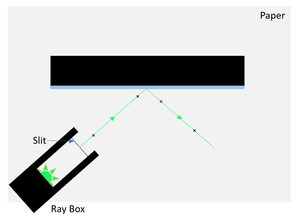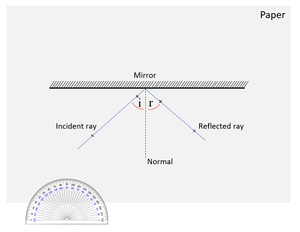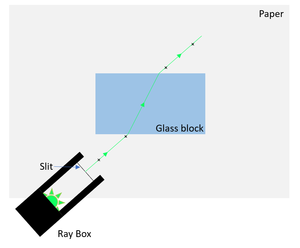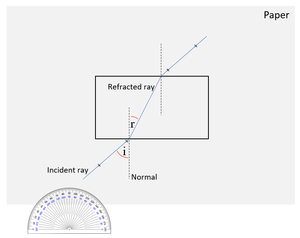GCSE Physics Required Practical: Investigating Reflection and Refraction of Light
Contents
Key Stage 4
Meaning
Investigate the reflection and refraction of light.
Experiment 1: Reflection from a Plane Mirror
Method
| A pair of diagrams of the apparatus used to investigate the reflection of light. | |
- Place a plane mirror in the centre of a piece of paper and draw a pencil line along its reflective side.
- Use a ray box and a slit to allow a single beam of light to be incident on the surface of the mirror at an angle less than 90°.
- Place a pair of x's on the incident ray and along the reflected ray.
- Remove the ray box and mirror.
- Use a ruler to join the x's with a pair of lines leading to the mirror to show the direction of the incident and reflected rays.
- Use a protractor and ruler to draw a normal line at right angles to the surface of the mirror at the point the light rays meet the mirror.
- Use the protractor to measure the 'i' the angle of incidence and 'r' the angle of reflection.
- Repeat this procedure for a number of different angles of incidence.
Improving Accuracy
- Drawing the rays longer and using a larger protractor may reduce the error in reading the protractor and improve accuracy.
Experiment 2: Refraction from a Rectangular Glass Block
Method
| A pair of diagrams of the apparatus used to investigate the refraction of light. | |
- Place a rectangular glass block in the centre of a piece of paper and draw a pencil line around the outside.
- Use a ray box and a slit to allow a single beam of light to be incident on the surface of the glass block at an angle less than 90°.
- Place a pair of x's on the incident ray and along the emergent ray.
- Remove the ray box and glass block.
- Use a ruler to join the x's with a pair of lines leading to the glass block to show the direction of the incident and emergent rays.
- Join the emergent ray and the incident ray with a line to represent the refracted ray.
- Use a protractor and ruler to draw a normal line at right angles to the surface of the glass block at the point the light rays meet the glass block.
- Use the protractor to measure the 'i' the angle of incidence and 'r' the angle of refraction.
- Repeat this procedure for a number of different angles of incidence.
Improving Accuracy
- Drawing the rays longer and using a larger protractor may reduce the error in reading the protractor and improve accuracy.



